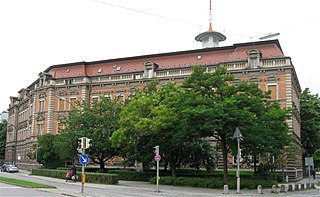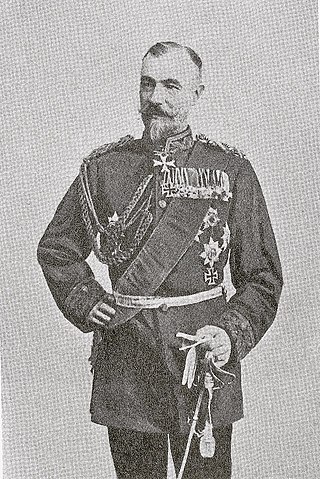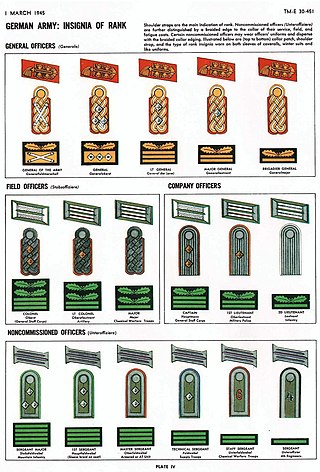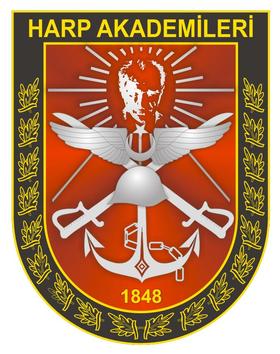
Gerhard Johann David von Scharnhorst was a Hanoverian-born general in Prussian service from 1801. As the first Chief of the Prussian General Staff, he was noted for his military theories, his reforms of the Prussian army, and his leadership during the Napoleonic Wars. Scharnhorst limited the use of corporal punishments, established promotion for merit, abolished the enrollment of foreigners, began the organization of a reserve army, and organized and simplified the military administration.

The German General Staff, originally the Prussian General Staff and officially the Great General Staff, was a full-time body at the head of the Prussian Army and later, the German Army, responsible for the continuous study of all aspects of war, and for drawing up and reviewing plans for mobilization or campaign. It existed unofficially from 1806, and was formally established by law in 1814, the first general staff in existence. It was distinguished by the formal selection of its officers by intelligence and proven merit rather than patronage or wealth, and by the exhaustive and rigorously structured training which its staff officers undertook.

Adrian Friedrich Wilhelm Julius Ludwig von Verdy du Vernois, often given the short name of Verdy, was a German general and staff officer, chiefly noted both for his military writings and his service on Helmuth von Moltke the Elder's staff during the Franco-Prussian War.

Karl Friedrich von Steinmetz was a Prussian Generalfeldmarschall. He was born at Eisenach and joined the army of Prussia during the War of Liberation. Over the Seven Weeks' War he led the V Corps against Austria and became known as the Lion of Nachod for his victories as the Battles of Nachod, Skalitz, and Schweinschädel. Steinmetz commanded one of three armies assembled on the Rhine for the Franco-Prussian War, during which he quarreled with Prince Friedrich Karl. After the war he retired.
Panzertruppenschule I was originally formed as the Kraftfahrkampftruppenschule on 1 October 1937 at Wünsdorf. A year later it was renamed to Panzertruppenschule. It was the first of two major schools set up by the German Panzerwaffe before World War II to train German armour officers to operate Panzers.
Staff colleges train military officers in the administrative, military staff and policy aspects of their profession. It is usual for such training to occur at several levels in a career. For example, an officer may be sent to various staff courses: as a captain they may be sent to a single service command and staff school to prepare for company command and equivalent staff posts; as a major to a single or joint service college to prepare for battalion command and equivalent staff posts; and as a colonel or brigadier to a higher staff college to prepare for brigade and division command and equivalent postings.

The Prussian Staff College, also Prussian War College was the highest military facility of the Kingdom of Prussia to educate, train, and develop general staff officers.
Kriegsakademie may refer to:

The Army War College; Short form: Rikudai (陸大) of the Empire of Japan was founded in 1882 in Minato, Tokyo to modernize and Westernize the Imperial Japanese Army. Much of the empire's elite including prime ministers during the period of Japanese militarism were graduates of the college.

The Feldgendarmerie were a type of military police units of the armies of the Kingdom of Saxony, the German Empire and Nazi Germany until the conclusion of World War II in Europe.

The Royal Prussian Army served as the army of the Kingdom of Prussia. It became vital to the development of Prussia as a European power.

The Bavarian War College, also Bavarian Staff College was the highest military facility to educate, instruct, train, and develop general staff officers.

Walther Franz Georg Bronsart von Schellendorff, Dr. jur. h.c., was a Prussian General of the Infantry à la suite, Adjutant-General to the Kaiser and King, and Prussian Minister of War.
A corps of cadets, also called cadet corps, is a type of military school intended to prepare cadets for a military life, with the school typically incorporating real military structure and ranks within their respective program.

The Heer as the German army and part of the Wehrmacht inherited its uniforms and rank structure from the Reichsheer of the Weimar Republic (1921–1935). There were few alterations and adjustments made as the army grew from a limited peacetime defense force of 100,000 men to a war-fighting force of several million men.

Turkish War Academies was an educational branch of the Turkish Armed Forces. It trained staff officers for Turkish Armed Forces.

Johannes Karl Louis Richard Eben, from 1906 named von Eben was a Prussian officer who served as a German general of the infantry in World War I.

Erich Prigge (1878–1955) was a German army officer, who served in both the German Imperial Army and the Ottoman Army during World War I, and ultimately attained the rank of major. Prigge is best known as the long-serving adjutant to Marshal Otto Liman von Sanders (1914–19) and as a military memoirist.
German people, culture, science and institutions have greatly influenced Chile. Following the Chilean independence in 1818, German influence increased gradually with Imperial Germany effectively displacing France as the prime role model for Chile in the second half of the 19th century. Settlement by ethnic German settlers has had a long-lasting influence on the society, economy and geography of Chile in general, and South Chile in particular.

The Artillerie Prüfungskommission, was founded in 1809 as part of the artillery of the Prussian Army. It was responsible for answering technical questions, testing the quality of new artillery materiel, and excuting experiments. The Artillerie Prüfungskommission later became part of the Imperial German Army. Other nations had equivalent authorities, e.g. the Austro-Hungarian was called Artilleriekomitee. The former headquarters of the Artillerie Prüfungskommission on the Bundesallee in Berlin are still standing.















